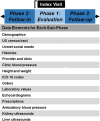The Study of the Epidemiology of Pediatric Hypertension Registry (SUPERHERO): rationale and methods
- PMID: 38881045
- PMCID: PMC11637526
- DOI: 10.1093/aje/kwae116
The Study of the Epidemiology of Pediatric Hypertension Registry (SUPERHERO): rationale and methods
Abstract
Despite increasing prevalence of hypertension in youth and high adult cardiovascular mortality rates, the long-term consequences of youth-onset hypertension remain unknown. This is due to limitations of prior research, such as small sample sizes, reliance on manual record review, and limited analytic methods, that did not address major biases. The Study of the Epidemiology of Pediatric Hypertension (SUPERHERO) is a multisite, retrospective registry of youth evaluated by subspecialists for hypertension disorders. Sites obtain harmonized electronic health record data using standardized biomedical informatics scripts validated with randomized manual record review. Inclusion criteria are index visit for International Classification of Diseases, 10th Revision (ICD-10) code-defined hypertension disorder on or after January 1, 2015, and age < 19 years. We exclude patients with ICD-10 code-defined pregnancy, kidney failure on dialysis, or kidney transplantation. Data include demographics, anthropomorphics, US Census Bureau tract, histories, blood pressure, ICD-10 codes, medications, laboratory and imaging results, and ambulatory blood pressure. SUPERHERO leverages expertise in epidemiology, statistics, clinical care, and biomedical informatics to create the largest and most diverse registry of youth with newly diagnosed hypertension disorders. SUPERHERO's goals are to reduce CVD burden across the life course and establish gold-standard biomedical informatics methods for youth with hypertension disorders.
Keywords: biomedical informatics; blood pressure; cardiovascular health; causal inference; child health; electronic health record; life course; youth.
© The Author(s) 2024. Published by Oxford University Press on behalf of the Johns Hopkins Bloomberg School of Public Health.
Conflict of interest statement
A.M.S. reports paid consultation from CSPC Ouyi Pharmaceutical Company, Ltd. M.B.B. reports ownership of Abbott Laboratory stock and compensation for a talk from Vitaflo. The other authors declare no conflicts.
Figures






References
Publication types
MeSH terms
Grants and funding
- UL1 TR001863/TR/NCATS NIH HHS/United States
- Wake Forest University School of Medicine Clinical and Translational Science Institute and Atrium Health Translational Research Initiative Joint Pilot Project Award
- R01-HL162912/HL/NHLBI NIH HHS/United States
- UL1 TR001420/TR/NCATS NIH HHS/United States
- K23-HL148394/NIH National Heart, Lung, and Blood Institute
- R01 DK131091/DK/NIDDK NIH HHS/United States
- R01 HL162912/HL/NHLBI NIH HHS/United States
- R01-DK131091/NIH National Institute of Diabetes and Digestive and Kidney Diseases
- UL1TR001420/National Institutes of Health (NIH) National Center for Advancing Translational Sciences
- K23 HL148394/HL/NHLBI NIH HHS/United States
- L40 HL148910/HL/NHLBI NIH HHS/United States
- R01 HL146818/HL/NHLBI NIH HHS/United States
- Canadian Institutes of Health Research and Kidney Foundation of Canada
LinkOut - more resources
Full Text Sources
Medical

